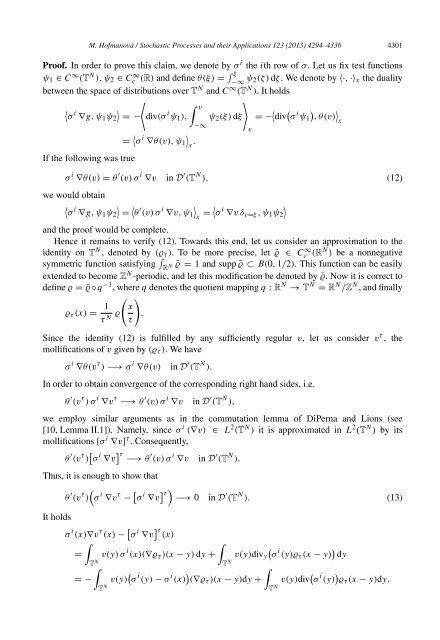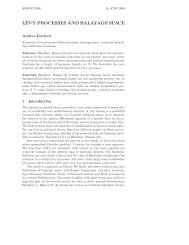Degenerate parabolic stochastic partial differential equations
Degenerate parabolic stochastic partial differential equations
Degenerate parabolic stochastic partial differential equations
You also want an ePaper? Increase the reach of your titles
YUMPU automatically turns print PDFs into web optimized ePapers that Google loves.
M. Hofmanová / Stochastic Processes and their Applications 123 (2013) 4294–4336 4301<br />
Proof. In order to prove this claim, we denote by σ i the ith row of σ . Let us fix test functions<br />
ψ 1 ∈ C ∞ (T N ), ψ 2 ∈ Cc ∞(R) and define θ(ξ) = ξ<br />
−∞ ψ 2(ζ ) dζ . We denote by ⟨·, ·⟩ x the duality<br />
between the space of distributions over T N and C ∞ (T N ). It holds<br />
<br />
<br />
σ i v<br />
∇g, ψ 1 ψ 2 = − div(σ i ψ 1 ), ψ 2 (ξ) dξ = − div σ i <br />
ψ 1 , θ(v)<br />
x<br />
If the following was true<br />
= σ i ∇θ(v), ψ 1<br />
x .<br />
−∞<br />
σ i ∇θ(v) = θ ′ (v) σ i ∇v in D ′ (T N ), (12)<br />
we would obtain<br />
<br />
σ i ∇g, ψ 1 ψ 2<br />
<br />
=<br />
<br />
θ ′ (v) σ i ∇v, ψ 1<br />
x = σ i ∇v δ v=ξ , ψ 1 ψ 2<br />
<br />
and the proof would be complete.<br />
Hence it remains to verify (12). Towards this end, let us consider an approximation to the<br />
identity on T N , denoted by (ϱ τ ). To be more precise, let ˜ϱ ∈ Cc ∞(RN ) be a nonnegative<br />
symmetric function satisfying R N ˜ϱ = 1 and supp ˜ϱ ⊂ B(0, 1/2). This function can be easily<br />
extended to become Z N -periodic, and let this modification be denoted by ¯ϱ. Now it is correct to<br />
define ϱ = ¯ϱ ◦q −1 , where q denotes the quotient mapping q : R N → T N = R N /Z N , and finally<br />
<br />
ϱ τ (x) = 1<br />
τ N ϱ x<br />
.<br />
τ<br />
Since the identity (12) is fulfilled by any sufficiently regular v, let us consider v τ , the<br />
mollifications of v given by (ϱ τ ). We have<br />
σ i ∇θ(v τ ) −→ σ i ∇θ(v) in D ′ (T N ).<br />
In order to obtain convergence of the corresponding right hand sides, i.e.<br />
θ ′ (v τ ) σ i ∇v τ −→ θ ′ (v) σ i ∇v in D ′ (T N ),<br />
we employ similar arguments as in the commutation lemma of DiPerna and Lions (see<br />
[10, Lemma II.1]). Namely, since σ i (∇v) ∈ L 2 (T N ) it is approximated in L 2 (T N ) by its<br />
mollifications [σ i ∇v] τ . Consequently,<br />
θ ′ (v τ ) σ i ∇v τ −→ θ ′ (v) σ i ∇v in D ′ (T N ).<br />
Thus, it is enough to show that<br />
<br />
θ ′ (v τ ) σ i ∇v τ − σ i ∇v τ<br />
−→ 0 in D ′ (T N ). (13)<br />
It holds<br />
σ i (x)∇v τ (x) − σ i ∇v τ (x)<br />
<br />
<br />
= v(y) σ i <br />
(x)(∇ϱ τ )(x − y) dy + v(y)div y σ i (y)ϱ τ (x − y) dy<br />
T N T<br />
<br />
N<br />
= − v(y) σ i (y) − σ i (x) <br />
(∇ϱ τ )(x − y)dy + v(y)div σ i (y) ϱ τ (x − y)dy.<br />
T N T N<br />
x



